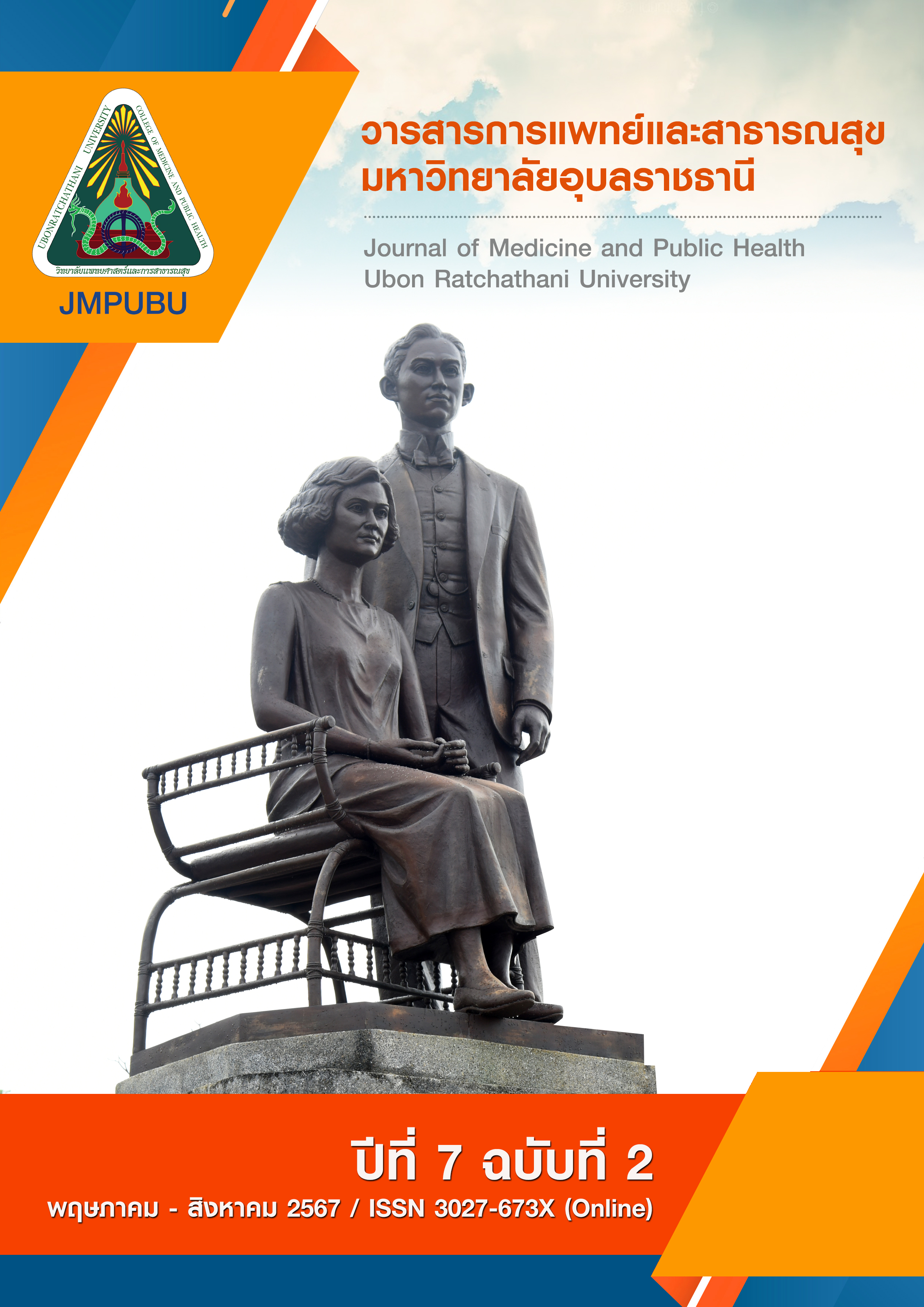ผลการคัดกรองการได้ยินในทารกแรกเกิดของโรงพยาบาลกระบี่
คำสำคัญ:
ทารกแรกเกิด , เครื่องตรวจวัดเสียงสะท้อนจากหูชั้นใน , การคัดกรองการได้ยินบทคัดย่อ
การตรวจคัดกรองการได้ยินในทารกแรกเกิดด้วยเครื่องตรวจวัดเสียงสะท้อนจากหูชั้นใน (otoacoustic emission; OAE) ทำได้ง่าย รวดเร็ว และไม่ก่อให้เกิดอันตรายแก่เด็ก การตรวจคัดกรองตั้งแต่แรกเกิดจะทำให้พบความพิการได้เร็วขึ้นทำให้เด็กได้รับการฟื้นฟูเร็วขึ้น การศึกษานี้มีวัตถุประสงค์เพื่อศึกษาผลการคัดกรองการได้ยินในทารกแรกเกิดด้วยเครื่อง OAEเป็นการศึกษาเชิงพรรณนาภาคตัดขวางในทารกแรกเกิดโรงพยาบาลกระบี่ ตั้งแต่ 1 กันยายน ถึง 30 กันยายน พ.ศ. 2566 ที่ได้รับการตรวจคัดกรองการได้ยินด้วยเครื่อง OAE และมีการบันทึกผลการทดสอบไว้ในเวชระเบียน กรณีตรวจพบความผิดปกติของการได้ยินตั้งแต่การคัดกรองครั้งแรกจะมีการนัดติดตามเพื่อตรวจยืนยันการวินิจฉัยการได้ยินบกพร่อง โดยทำการตรวจซ้ำ และมีการบันทึกผลการทดสอบไว้ในเวชระเบียน ผลการศึกษา พบว่า มีทารกแรกเกิดที่ได้รับการตรวจคัดกรองการได้ยินก่อนออกจากโรงพยาบาลจำนวน 96 ราย ผลการตรวจคัดกรองด้วย OAE ครั้งแรก พบว่าไม่ผ่าน 8 ราย (ร้อยละ 8.3) เป็นการตรวจคัดกรองครั้งแรกก่อนอายุ 2 วัน ร้อยละ 43.7 ผลการตรวจคัดกรองด้วย OAE ครั้งที่สองจำนวน 8 ราย พบว่าผ่านทุกราย เป็นทารกได้รับการตรวจคัดกรองซ้ำภายใน 30 วัน ร้อยละ 62.5 การศึกษานี้ไม่พบการสูญเสียการได้ยินในทารกแรกเกิด แต่เนื่องจากความผิดปกติของการได้ยินมีความสำคัญมากต่อคุณภาพชีวิต จึงควรมีการตรวจคัดกรองการได้ยินในทารกแรกเกิดทุกรายและควรมีการศึกษาเพิ่มเติมถึงประสิทธิภาพการตรวจคัดกรองการได้ยินด้วยเครื่อง OAE
Downloads
เอกสารอ้างอิง
Chinnacom D, Kittiratchakool N, Luankongsomchit V, Ekakkararungroj C, Kittibovorndit N, Tantivess S, et al. Scaling up newborn hearing screening program in Thailand: A study on the feasibility, costs, and cost-effectiveness. 2nded. Nonthaburi: Health systems research institute; 2023.
Kongthong R, Natepinyo S, Kearttiwongkru S. Newborn hearing screening in Nakhonpathom hospital. Region 6-7 medical journal. 2006;25(4):353-66.
Department of Otolaryngology. Newborn Hearing Screening at Rajavithi Hospital. 1st ed Bangkok: Rajavithi Hospital; 2020.
Titirungruang C, Charusripan P, Patarapak S. Early detection of infant hearing impairment. Chula Med J. 2018;62(1):53-65.
Downs MP, Yoshinaga-Itano C. The efficacy of early identification and intervention for children with hearing impairment. Pediatric Clinics. 1999;46(1):79-87.
Moeller MP. Early intervention and language development in children who are deaf and hard of hearing. Pediatrics. 2000;106(3):e43-e.
Yoshinaga-Itano C, Sedey AL, Coulter DK, Mehl AL. Language of early-and later-identified children with hearing loss. Pediatrics. 1998;102(5):1161-71.
Joint Committee on Infant Hearing. Year 2007 position statement: Principles and guidelines for early hearing detection and intervention programs. Pediatrics. 2007;120(4):898-921.
Khaimook W, Chayarpham S, Dissaneevate S. The high-risk neonatal hearing screening program in Songklanagarind hospital. J Med Assoc Thai. 2008;91(1):1038–42.
Patel RR, Awan SN, Barkmeier-Kraemer J, Courey M, Deliyski D, Eadie T, et al. Recommended protocols for instrumental assessment of voice: American Speech-Language-Hearing Association expert panel to develop a protocol for instrumental assessment of vocal function. American journal of speech-language pathology. 2018;27(3):887-905.
Ng J, Yun HL. Otoacoustic emissions (OAE) in paediatric hearing screening--the Singapore experience. The Journal of the Singapore Paediatric Society. 1992;34(1-2):1-5.
Chojecki D, Harstall C, Yan C, Chuck AA, Corabian P. The safety and efficacy/
effectiveness of using automated testing devices for universal newborn hearing screening. 1sted .Alberta: STE Report; 2012.
Heidari S, Manesh AO, Rajabi F. The sensitivity and specificity of automated auditory brainstem response and otoacoustic emission in neonatal hearing screening: a systematic review. Auditory and vestibular research. 2015;24(3):141-51.
Akinpelu OV, Peleva E, Funnell WRJ, Daniel SJ. Otoacoustic emissions in newborn hearing screening: A systematic review of the effects of different protocols on test outcomes. International Journal of Pediatric Otorhinolaryngology. 2014;78(5):711-7.
Chindavijak S, Tanamai N, Khongsaksri A, Withyapraphaiphan S, Khitchaidiao A, Susonthitaphong R, et al. Cost effectiveness of newborn hearing screening protocol in reduction of refer newborn hearing loss for diagnosis. Journal of the department of medical services. 2021;46(4):120-9.
Daniel WW, Cross CL. Biostatistics: a foundation for analysis in the health sciences. 11thed. New York: Wiley; 2018.
Srisubat A, Imsuwansri T, Mukkun T, Thaiyakul A, Konlaeaid S, Limpichaisopon K, et al. Model development for universal newborn hearing screening (UNHS) in province level: action research. Journal of the department of medical services. 2022;46(1):160-9.
Tungvachirakul V, Boonmee S, Nualmoosik T, Kamjohnjiraphun J, Sanghirun W, Potaporn M. Newborn hearing screening at Rajavithi Hospital, Thailand: hearing loss in infants not admitting in intensive care unit. Journal of the Medical Association of Thailand. 2011;94(3):108.
Thongsrinuch P, Junthong S. Prevalence of early hearing detection and intervention newborn in Vajira hospital. Vajira Medical Journal. 2021;65(1):39-52.
Olawanit W. Neonatat hearing screening program by otoacoustic emission at Buriram hospital. Medical journal of Srisaket Surin Buriram hospitals. 2011;26(2):286-94.
Benjarattanaporn T. Outcome of two stage newborn hearing screening protocol in Rajavithi hospital. 1st ed. Bangkok: Otorhinolaryngology-Head and Neck Surgery of Rajavithi hospital; 2019.
Sanphon T, Channarong M. Incidence and associated factors of hearing disorder in newborns at Sichon hospital Nakhon Si Thammarat province. Region 11 Medical Journal. 2021;36(1):11-21.
Saetae T. High risk neonatal hearing screening program at Chumphon Khet Udomsak hospital. Region 11 Medical Journal. 2016;30(2):31-6.
ดาวน์โหลด
เผยแพร่แล้ว
รูปแบบการอ้างอิง
ฉบับ
ประเภทบทความ
สัญญาอนุญาต
ลิขสิทธิ์ (c) 2024 วารสารการแพทย์และสาธารณสุข มหาวิทยาลัยอุบลราชธานี

อนุญาตภายใต้เงื่อนไข Creative Commons Attribution-NonCommercial-NoDerivatives 4.0 International License.
เนื้อหาและข้อมูลในบทความที่ลงตีพิมพ์ในวารสารการแพทย์และสาธารณสุข มหาวิทยาลัยอุบลราชธานี ถือเป็นข้อคิดเห็นและความรับผิดชอบของผู้เขียนบทความโดยตรง ซึ่งกองบรรณาธิการวารสารไม่จำเป็นต้องเห็นด้วย หรือร่วมรับผิดชอบใด ๆ
บทความ ข้อมูล เนื้อหา รูปภาพ ฯลฯ ที่ได้รับการตีพิมพ์ในวารสารการแพทย์และสาธารณสุข มหาวิทยาลัยอุบลราชธานี ถือเป็นลิขสิทธิ์ของวารสารการแพทย์และสาธารณสุข มหาวิทยาลัยอุบลราชธานี กองบรรณาธิการไม่สงวนสิทธิ์ในการคัดลอกเพื่อการพัฒนางานด้านวิชาการ แต่ต้องได้รับการอ้างอิงที่ถูกต้องเหมาะสม






